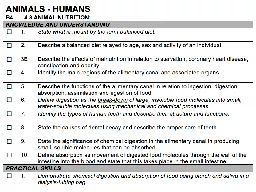

mechanical and chemical processes This occurs in the Alimentary Canal Alimentary canal long muscular tube that runs from the mouth to the anus Peristalsis muscular movement of food ID: 908489
Download Presentation The PPT/PDF document "Digestion: Break-down of large, insolub..." is the property of its rightful owner. Permission is granted to download and print the materials on this web site for personal, non-commercial use only, and to display it on your personal computer provided you do not modify the materials and that you retain all copyright notices contained in the materials. By downloading content from our website, you accept the terms of this agreement.
Slide1
Slide2Digestion:
Break-down of large, insoluble food molecules into small, water-soluble molecules using mechanical and chemical processes.This occurs in the Alimentary Canal…
Slide3Alimentary canal
– long muscular tube that runs from the mouth to the
anus.
Peristalsis
– muscular movement of food
Slide4Before the body can make use of the food you eat, the food has to be broken down to release the nutrients (
digested).The nutrients are then absorbed
into the
bloodstream
and taken to the cells where they can be used.
Four Digestion processesIngestionDigestionAbsorptionEgestion
Slide5Overview!
Slide6Not All food needs digesting!
Simple sugars, water, vitamins & minerals are small molecules and can be absorbed as they are – they do not need to be digested!
Where
does absorption take place…?
Slide7Food group
Mechanical
-Teeth / stomach…
Specific enzymes do their bit…
End product
…
but
absorbed where…
?
Slide8M
ain
regions of the
alimentary canal
and associated
organs
Mechanical
Digestion?
Chemical
Digestion?
Slide9Is the taking in of food into the mouth and swallowing it
Teeth and jaws grind the food into smaller bits
Ingestion
The
oesophagus
is
the tube which connects the mouth to the stomach
The saliva in the mouth contains
enzyme
(
Amylase
)
which
helps break up food chemically.
Slide10Is the
breaking-up of food into small soluble pieces.
Food in the stomach is mixed up and stored (turned into a soup-like liquid)
Stomach cells make enzymes (
Pepsin)
and hydrochloric acid
are released to aid digestion
Digestion
This acid also kills
bacteria present
in food.
Stomach – bag with lots of muscle in its walls…
Food held ~ 1-4 hours, liquids ~ a few minutes
Slide11Food is then slowly released into the
small intestine
(gut
) where
most of the digestion happens.
First part –
Duodenum
Where pancreas & bile fluids added joins
Slide12Is when food nutrients
pass
through
the gut wall and into the blood stream.
The lining of the small intestine is folded and has little finger-like projections called
villi
which increase the area for absorption.
Absorption
The
surface is
only one cell thick
which speeds up the absorption of nutrients
.
Cells covering the villi make enzymes
eg
Lactase (breaks down lactose in milk)
Slide13What about the Liver?
Blood from the digestive system must first filter through the liver before it travels anywhere else in the body.
The principal roles of the liver include removing toxins from the body, processing food nutrients and helping to regulate body
metabolism (how your body gets its energy). Also produces bile…
Slide14In the
Large Intestine (colon & Rectum), w
ater
and any remaining minerals are
absorbed
What is left consists of remnants of fibre, other undigested material and bacteria.
Egestion
The remains are formed into solid wastes (
faeces
/
poo
) and stored in
rectum
.
They are removed from the body through the
anus
.
Slide15